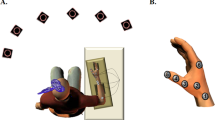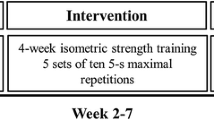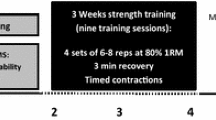Abstract
There is evidence of a strong capacity for functional and structural reorganization in the human motor system. However, past research has focused mainly on complex movement sequences over rather short training durations. In this study we investigated changes in corticospinal excitability associated with longer training of elementary, maximum-speed tapping movements. All participating subjects were consistent right-handers and were trained using either the right (experiment 1) or the left thumb (experiment 2). Transcranial magnetic stimulation was applied to obtain motor evoked potentials (MEPs) from the abductor pollicis brevis (APB) muscle of the right and the left hand before and after training. As a result of training, a significant increase was observed in tapping speed accompanied by increased MEPs, recorded from the trained APB muscle, following contralateral M1 stimulation. In the case of subdominant-hand training we additionally demonstrate increased MEP amplitudes evoked at the right APB (untrained hand) in the first training week. Enhanced corticospinal excitability associated with practice of elementary movements may constitute a necessary precursor for inducing plastic changes within the motor system. The involvement of the ipsilateral left M1 likely reflects the predominant role of the left M1 in the general control (modification) of simple motor parameters in right-handed subjects.



Similar content being viewed by others
Abbreviations
- ADM:
-
Abductor digiti minimi
- APB:
-
Abductor pollicis brevis
- CMAP:
-
Compound muscle action potential
- EMG:
-
Electromyography
- ITI:
-
Inter-tap-interval
- M1:
-
Primary motor cortex
- MEP:
-
Motor evoked potential
- RMT:
-
Resting motor threshold
- TMS:
-
Transcranial magnetic stimulation
References
Agnew JA, Zeffiro TA, Eden GF (2004) Left hemisphere specialization for the control of voluntary movement rate. Neuroimage 22(1):289–303
Alkadhi H, Crelier GR, Boendermaker SH, Hepp-Reymond MC, Kollias SS (2002) Somatotopy in the ipsilateral primary motor cortex. Neuroreport 13(16):2065–2070
Amunts K, Schlaug G, Jäncke L, Steinmetz H, Schleicher A, Zilles K (1997) Hand skills covary with the size of motor cortex: a macrostructural adaptation. Hum Brain Mapp 5:206–215
Andres FG, Gerloff C (1999) Coherence of sequential movements and motor learning. J Clin Neurophysiol 16(6):520–527
Annett M (1970) A classification of hand preference by association analysis. Br J Psychol 61(3):303–321
Annett M, Hudson PT, Turner A (1974) The reliability of differences between the hands in motor skill. Neuropsychologia 12(4):527–531
Ashe J, Georgopoulos AP (1994) Movement parameters and neural activity in motor cortex and area 5. Cereb Cortex 4(6):590–600
Baraldi P, Porro CA, Serafini M, Pagnoni G, Murari C, Corazza R, Nichelli P (1999) Bilateral representation of sequential finger movements in human cortical areas. Neurosci Lett 269(2):95–98
Beltramello A, Cerini R, Puppini G, El-Dalati G, Viola S, Martone E, Cordopatri D, Manfredi M, Aglioti S, Tassinari G (1998) Motor representation of the hand in the human cortex: an f-MRI study with a conventional 1.5 T clinical unit. Ital J Neurol Sci 19(5):277–284
Caramia MD, Palmieri MG, Giacomini P, Iani C, Dally L, Silvestrini M (2000) Ipsilateral activation of the unaffected motor cortex in patients with hemiparetic stroke. Clin Neurophysiol 111(11):1990–1996
Carey LM, Abbott DF, Egan GF, Tochon-Danguy HJ, Donnan GA (2000) The functional neuroanatomy and long-term reproducibility of brain activation associated with a simple finger tapping task in older healthy volunteers: a serial PET study. Neuroimage 11(2):124–144
Catalan MJ, Honda M, Weeks RA, Cohen LG, Hallett M (1998) The functional neuroanatomy of simple and complex sequential finger movements: a PET study. Brain 121(Pt 2):253–264
Chen R, Cohen LG, Hallett M (1997a) Role of the ipsilateral motor cortex in voluntary movement. Can J Neurol Sci 24(4):284–291
Chen R, Gerloff C, Hallett M, Cohen LG (1997b) Involvement of the ipsilateral motor cortex in finger movements of different complexities. Ann Neurol 41(2):247–254
Classen J, Liepert J, Wise SP, Hallett M, Cohen LG (1998) Rapid plasticity of human cortical movement representation induced by practice. J Neurophysiol 79(2):1117–1123
Classen J, Liepert J, Hallett M, Cohen L (1999) Plasticity of movement representation in the human motor cortex. Electroencephalogr Clin Neurophysiol Suppl 51:162–173
Cohen J (1988) Statistical power analysis for the behavioral sciences. Lawrence Erlbaum Associates, Hillsdale
Cohen LG, Brasil-Neto JP, Pascual-Leone A, Hallett M (1993) Plasticity of cortical motor output organization following deafferentation, cerebral lesions, and skill acquisition. Adv Neurol 63:187–200
Cohen LG, Ziemann U, Chen R, Classen J, Hallett M, Gerloff C, Butefisch C (1998) Studies of neuroplasticity with transcranial magnetic stimulation. J Clin Neurophysiol 15(4):305–324
Cramer SC, Finklestein SP, Schaechter JD, Bush G, Rosen BR (1999) Activation of distinct motor cortex regions during ipsilateral and contralateral finger movements. J Neurophysiol 81(1):383–387
Dejardin S, Dubois S, Bodart JM, Schiltz C, Delinte A, Michel C, Roucoux A, Crommelinck M (1998) PET study of human voluntary saccadic eye movements in darkness: effect of task repetition on the activation pattern. Eur J Neurosci 10(7):2328–2336
Donoghue JP, Suner S, Sanes JN (1990) Dynamic organization of primary motor cortex output to target muscles in adult rats. II. Rapid reorganization following motor nerve lesions. Exp Brain Res 79(3):492–503
Facchini S, Romani M, Tinazzi M, Aglioti SM (2002) Time-related changes of excitability of the human motor system contingent upon immobilisation of the ring and little fingers. Clin Neurophysiol 113(3):367–375
Garry MI, Kamen G, Nordstrom MA (2004) Hemispheric differences in the relationship between corticomotor excitability changes following a fine-motor task and motor learning. J Neurophysiol 91(4):1570–1578
Grafton ST, Mazziotta JC, Presty S, Friston KJ, Frackowiak RS, Phelps ME (1992) Functional anatomy of human procedural learning determined with regional cerebral blood flow and PET. J Neurosci 12(7):2542–2548
Hallett M (1995) The plastic brain. Ann Neurol 38(1):4–5
Halsband U (1992) Left hemisphere preponderance in trajectorial learning. Neuroreport 3(5):397–400
Hammond G, Bolton Y, Plant Y, Manning J (1988) Hand asymmetries in interresponse intervals during rapid repetitive finger tapping. J Mot Behav 20(1):67–71
Harrington DL, Rao SM, Haaland KY, Bobholz JA, Mayer AR, Binderx JR, Cox RW (2000) Specialized neural systems underlying representations of sequential movements. J Cogn Neurosci 12(1):56–77
Haslinger B, Erhard P, Weilke F, Ceballos-Baumann AO, Bartenstein P, Grafin von EH, Schwaiger M, Conrad B, Boecker H (2002) The role of lateral premotor-cerebellar-parietal circuits in motor sequence control: a parametric fMRI study. Brain Res Cogn Brain Res 13(2):159–168
Haslinger B, Erhard P, Altenmuller E, Hennenlotter A, Schwaiger M, Grafin von EH, Rummeny E, Conrad B, Ceballos-Baumann AO (2004) Reduced recruitment of motor association areas during bimanual coordination in concert pianists. Hum Brain Mapp 22(3):206–215
Hayashi S, Hasegawa Y, Kasai T (2002) Transcranial magnetic stimulation study of plastic changes of human motor cortex after repetitive simple muscle contractions. Percept Mot Skills 95(3 Pt 1):699–705
Hazeltine E, Grafton ST, Ivry R (1997) Attention and stimulus characteristics determine the locus of motor-sequence encoding. A PET study. Brain 120(Pt 1):123–140
Hess CW, Mills KR, Murray NM (1987) Responses in small hand muscles from magnetic stimulation of the human brain. J Physiol 388:397–419
Hlustik P, Solodkin A, Noll DC, Small SL (2004) Cortical plasticity during three-week motor skill learning. J Clin Neurophysiol 21(3):180–191
Holm S (1979) A simple sequentially rejective multiple test procedure. Scand J Stat 6:65–70
Huang MX, Harrington DL, Paulson KM, Weisend MP, Lee RR (2004) Temporal dynamics of ipsilateral and contralateral motor activity during voluntary finger movement. Hum Brain Mapp 23(1):26–39
Humphrey DR (1972) Relating motor cortex spike trains to measures of motor performance. Brain Res 40(1):7–18
Iacoboni M, Woods RP, Mazziotta JC (1996) Brain–behavior relationships: evidence from practice effects in spatial stimulus–response compatibility. J Neurophysiol 76(1):321–331
Jacobs KM, Donoghue JP (1991) Reshaping the cortical motor map by unmasking latent intracortical connections. Science 251(4996):944–947
Jäncke L (1996) The hand performance test with a modified time limit instruction enables the examination of hand performance asymmetries in adults. Percept Mot Skills 82(3 Pt 1):735–738
Jäncke L, Peters M, Schlaug G, Posse S, Steinmetz H, Muller-Gartner H (1998) Differential magnetic resonance signal change in human sensorimotor cortex to finger movements of different rate of the dominant and subdominant hand. Brain Res Cogn Brain Res 6(4):279–284
Jäncke L, Specht K, Mirzazade S, Peters M (1999) The effect of finger-movement speed of the dominant and the subdominant hand on cerebellar activation: a functional magnetic resonance imaging study. Neuroimage 9(5):497–507
Jäncke L, Himmelbach M, Shah NJ, Zilles K (2000a) The effect of switching between sequential and repetitive movements on cortical activation. Neuroimage 12(5):528–537
Jäncke L, Shah NJ, Peters M (2000b) Cortical activations in primary and secondary motor areas for complex bimanual movements in professional pianists. Brain Res Cogn Brain Res 10(1–2):177–183
Jäncke L, Steinmetz H, Benilow S, Ziemann U (2004) Slowing fastest finger movements of the dominant hand with low-frequency rTMS of the hand area of the primary motor cortex. Exp Brain Res 155(2):196–203
Karni A, Meyer G, Jezzard P, Adams MM, Turner R, Ungerleider LG (1995) Functional MRI evidence for adult motor cortex plasticity during motor skill learning. Nature 377(6545):155–158
Karni A, Meyer G, Rey-Hipolito C, Jezzard P, Adams MM, Turner R, Ungerleider LG (1998) The acquisition of skilled motor performance: fast and slow experience-driven changes in primary motor cortex. Proc Natl Acad Sci USA 95(3):861–868
Kawashima R, Yamada K, Kinomura S, Yamaguchi T, Matsui H, Yoshioka S, Fukuda H (1993) Regional cerebral blood flow changes of cortical motor areas and prefrontal areas in humans related to ipsilateral and contralateral hand movement. Brain Res 623(1):33–40
Kawashima R, Matsumura M, Sadato N, Naito E, Waki A, Nakamura S, Matsunami K, Fukuda H, Yonekura Y (1998) Regional cerebral blood flow changes in human brain related to ipsilateral and contralateral complex hand movements—a PET study. Eur J Neurosci 10(7):2254–2260
Keselman HJ, Algina J, Kowalchuk RK (2001) The analysis of repeated measures designs: a review. Br J Math Stat Psychol 54(Pt 1):1–20
Kiers L, Cros D, Chiappa KH, Fang J (1993) Variability of motor potentials evoked by transcranial magnetic stimulation. Electroencephalogr Clin Neurophysiol 89(6):415–423
Kim SG, Ashe J, Hendrich K, Ellermann JM, Merkle H, Ugurbil K, Georgopoulos AP (1993) Functional magnetic resonance imaging of motor cortex: hemispheric asymmetry and handedness. Science 261(5121):615–617
Kobayashi M, Hutchinson S, Schlaug G, Pascual-Leone A (2003) Ipsilateral motor cortex activation on functional magnetic resonance imaging during unilateral hand movements is related to interhemispheric interactions. Neuroimage 20(4):2259–2270
Koeneke S, Lutz K, Wustenberg T, Jäncke L (2004) Long-term training affects cerebellar processing in skilled keyboard players. Neuroreport 15(8):1279–1282
Lotze M, Scheler G, Tan HR, Braun C, Birbaumer N (2003) The musician’s brain: functional imaging of amateurs and professionals during performance and imagery. Neuroimage 20(3):1817–1829
Loubinoux I, Carel C, Alary F, Boulanouar K, Viallard G, Manelfe C, Rascol O, Celsis P, Chollet F (2001) Within-session and between-session reproducibility of cerebral sensorimotor activation: a test–retest effect evidenced with functional magnetic resonance imaging. J Cereb Blood Flow Metab 21(5):592–607
Lutz K, Koeneke S, Wustenberg T, Jancke L (2005) Asymmetry of cortical activation during maximum and convenient tapping speed. Neurosci Lett 373(1):61–66
Morgen K, Kadom N, Sawaki L, Tessitore A, Ohayon J, Frank J, McFarland H, Martin R, Cohen LG (2004) Kinematic specificity of cortical reorganization associated with motor training. Neuroimage 21(3):1182–1187
Muellbacher W, Ziemann U, Boroojerdi B, Cohen L, Hallett M (2001) Role of the human motor cortex in rapid motor learning. Exp Brain Res 136(4):431–438
Munte TF, Altenmuller E, Jäncke L (2002) The musician’s brain as a model of neuroplasticity. Nat Rev Neurosci 3(6):473–478
Nyberg L, Eriksson J, Larsson A, Marklund P (2006) Learning by doing versus learning by thinking: an fMRI study of motor and mental training. Neuropsychologia 44(5):711–717
O’Brien RG, Kaiser MK (1985) MANOVA method for analyzing repeated measures designs: an extensive primer. Psychol Bull 97(2):316–333
Park SW, Butler AJ, Cavalheiro V, Alberts JL, Wolf SL (2004) Changes in serial optical topography and TMS during task performance after constraint-induced movement therapy in stroke: a case study. Neurorehabil Neural Repair 18(2):95–105
Pascual-Leone A, Grafman J, Hallett M (1994) Modulation of cortical motor output maps during development of implicit and explicit knowledge. Science 263(5151):1287–1289
Pascual-Leone A, Nguyet D, Cohen LG, Brasil-Neto JP, Cammarota A, Hallett M (1995) Modulation of muscle responses evoked by transcranial magnetic stimulation during the acquisition of new fine motor skills. J Neurophysiol 74(3):1037–1045
Pascual-Leone A, Amedi A, Fregni F, Merabet LB (2005) The plastic human brain cortex. Annu Rev Neurosci 28:377–401
Peters M (1976) Prolonged practice of a simple motor task by preferred and nonpreffered hands. Percept Mot Skills 42(43):447–450
Rajah M, Hussey D, Houle S, Kapur S, McIntosh AR (1998) Task-independent effect of time on rCBF. Neuroimage 7(4 Pt 1):314–325
Ridding MC, Rothwell JC (1997) Stimulus/response curves as a method of measuring motor cortical excitability in man. Electroencephalogr Clin Neurophysiol 105(5):340–344
Rosnow RL, Rosenthal R (1996) Computing contrasts, effect sizes, and counternulls on other people’s published data: general procedures for research consumers. Psychol Methods 1:331–340
Rossini PM, Barker AT, Berardelli A, Caramia MD, Caruso G, Cracco RQ, Dimitrijevic MR, Hallett M, Katayama Y, Lucking CH (1994) Non-invasive electrical and magnetic stimulation of the brain, spinal cord and roots: basic principles and procedures for routine clinical application. Report of an IFCN committee. Electroencephalogr Clin Neurophysiol 91(2):79–92
Sadato N, Campbell G, Ibanez V, Deiber M, Hallett M (1996) Complexity affects regional cerebral blood flow change during sequential finger movements. J Neurosci 16(8):2691–2700
Schulze K, Luders E, Jäncke L (2002) Intermanual transfer in a simple motor task. Cortex 38(5):805–815
Seidler RD, Purushotham A, Kim SG, Ugurbil K, Willingham D, Ashe J (2002) Cerebellum activation associated with performance change but not motor learning. Science 296(5575):2043–2046
Shadmehr R, Holcomb HH (1997) Neural correlates of motor memory consolidation. Science 277(5327):821–825
Steingruber HJ (1971) Measuring of laterality. Z Exp Angew Psychol 18(2):337–357
Toma K, Mima T, Matsuoka T, Gerloff C, Ohnishi T, Koshy B, Andres F, Hallett M (2002) Movement rate effect on activation and functional coupling of motor cortical areas. J Neurophysiol 88(6):3377–3385
Tracy JI, Faro SS, Mohammed F, Pinus A, Christensen H, Burkland D (2001) A comparison of ‘Early’ and ‘Late’ stage brain activation during brief practice of a simple motor task. Brain Res Cogn Brain Res 10(3):303–316
Ungerleider LG, Doyon J, Karni A (2002) Imaging brain plasticity during motor skill learning. Neurobiol Learn Mem 78(3):553–564
Verstynen T, Diedrichsen J, Albert N, Aparicio P, Ivry RB (2005) Ipsilateral motor cortex activity during unimanual hand movements relates to task complexity. J Neurophysiol 93(3):1209–1222
Yetkin FZ, McAuliffe TL, Cox R, Haughton VM (1996) Test–retest precision of functional MR in sensory and motor task activation. AJNR Am J Neuroradiol 17(1):95–98
Zanette G, Manganotti P, Fiaschi A, Tamburin S (2004) Modulation of motor cortex excitability after upper limb immobilization. Clin Neurophysiol 115(6):1264–1275
Ziemann U, Steinhoff BJ, Tergau F, Paulus W (1998) Transcranial magnetic stimulation: its current role in epilepsy research. Epilepsy Res 30(1):11–30
Acknowledgment
This work was supported by an NCCR-grant to L.J. (Swiss National Foundation, Neural plasticity and repair).
Author information
Authors and Affiliations
Corresponding author
Rights and permissions
About this article
Cite this article
Koeneke, S., Lutz, K., Herwig, U. et al. Extensive training of elementary finger tapping movements changes the pattern of motor cortex excitability. Exp Brain Res 174, 199–209 (2006). https://doi.org/10.1007/s00221-006-0440-8
Received:
Accepted:
Published:
Issue Date:
DOI: https://doi.org/10.1007/s00221-006-0440-8




